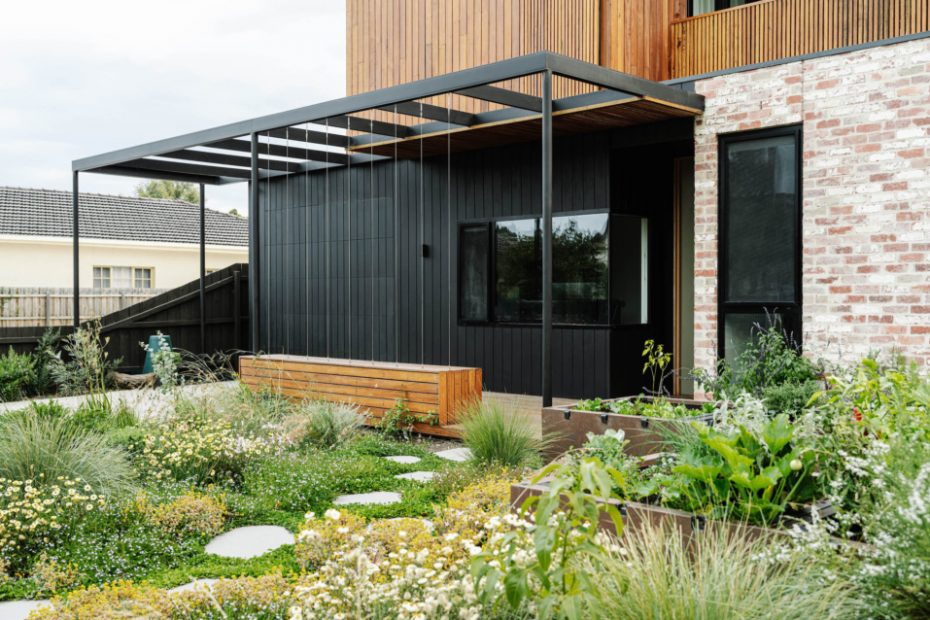A Fairfield Garden Designed To Look Beautiful In Every Season
Gardens
House of Life is a new garden by STEM Landscape Architecture and Design. Home designed by Ben Callery Architects. Windows by Nordic Windows + Doors.
The front yard features balsalt boulders surrounded by grasses like Poa labbilariedii (tussock-grass) and Themeda triandra (true blue) to attract insects and small birds.
Flowering plants like Brachyscome multifida (cut leaf daisy) have attracted a wide variety of pollinators — ‘from bees, flower wasps, hoverflies and butterflies’ — to the inner-city garden.
Biofilta food cubes provide an excellent wicking bed system for growing food.
The material palette of the house is softened by the plant selection.
Steppers lead to the front door.
The backyard features foilage around a lawn for the kids to play on. Vitis coignetiae (Crimson glory vine) climbs the pergola.
Pteris tremula (Australian brake) is planted in the corner.
Recycled timber posts create an open fence.
The view of the house from the street.
While every landscaping project or new build has an impact on the environment, STEM founder and landscape architect Emmaline Bowman’s guiding ethos is to leave each garden she touches ‘better than it was’ before.
This ecological-inspired approach was especially important when it came to designing the gardens for this new Fairfield family home in Melbourne’s north-east.
The owners — Christine, Anthony, their two teenaged kids and dog Luna — had engaged Ben Callery Architects for a full knock-down and rebuild, before asking STEM to revive what was initially an overgrown garden with completely new landscaping.
Christine wanted spaces she could ‘escape’ to and potter around; Anthony’s focus was growing his own food; and in the rear, they envisioned a lush green space that was sturdy enough for their kids to play.
The sunny front yard was the perfect spot for Emmaline to create a functional but inviting garden, characterised by a vibrant, lively planting palette that attracts attention both from passersby and local wildlife.
Subtle fencing allows interaction with those on the street, offering glimpses into the four raised Biofilta garden beds growing leafy produce and herbs. The mix of perennial plants like Isotoma axillaris (rock isotome), Pycnosorus globosus (billy buttons), and Brachyscome multifida (cutleaf daisy) envlop the productive plantings with charming small flowers and pops of colour.
‘They are incredible [plants] for attracting a wide variety of pollinators, from bees, flower wasps, hoverflies and butterflies,’ Emmaline says.
‘Now the garden gets people stopping all the time to take photos of it, and I hope they get to take a little bit of inspiration back into their own gardens.’
In the rear garden, the planting style transitions to a lush, green landscape that softens the structural elements of the outdoor dining area.
‘The pergola features a thoughtfully designed wire system created by Ben and his team, which we complemented by planting Vitis coignetiae,’ Emmaline adds. ‘It’s an ornamental grape vine that grows more slowly, but offers stunning fuller foliage and vibrant autumn colour.’
Continuing to play with seasonal colours, the backyard features native plants to ensure the landscaping looks beautiful in every season.
‘As it heats up, the yellows from the daisies and the Pycnosorus will start dominating the garden. In autumn, the dried spent flowers and seeds heads of the Themda (kangaroo grass) create a beautiful bouquet,’ Emmaline says.
‘And in winter the banksias offer some flowers, and the grasses maintain the movement and interest, providing protection to the other plants during wind and heavy weather. This constant transformation ensures the garden always feels alive and dynamic, no matter the time of year.’
